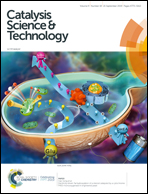Interfacially bonded CuCo2O4/TiO2 nanosheet heterostructures for boosting photocatalytic H2 production†
Abstract
Constructing high-performance, economical and environmentally friendly photocatalysts remains a challenge for the efficient conversion of solar energy. In this work, CuCo2O4 nanoparticles modified on TiO2 nanosheets have been designed and fabricated via a facile hydrothermal method followed by an in situ calcination process. The resultant 10%-CuCo2O4/TiO2 heterostructure exhibited superior photocatalytic activity under full spectra. The H2 generation rate can reach 4830 μmol g−1 h−1 under 300 W Xe lamp irradiation, which is 32 times higher than that of pristine TiO2 and the highest fold increase of a binary TiO2-based non-noble system reported so far. Its apparent quantum yield (AQY) value can reach 11.5% at 365 nm. Furthermore, we demonstrate that there are chemical bonds formed at the interface between well-dispersed CuCo2O4 and TiO2 by XPS spectrometry and electronegativity theory, and the efficient separation of charge carriers due to the p–n junction adopting the interfacial Ti–O–Cu/Co bonds is crucial for the improved performance and photostability. This work develops possibilities to prepare feasible CuCo2O4-based heterostructures for energy conversion.



 Please wait while we load your content...
Please wait while we load your content...